Edgartown at any price is a bargain compared to friendly Amity. The white wooden houses of the Vineyard are kept just as neatly as those of Jaws’ picturesque resort; the waters are no less beautiful around the Island; even the inhabitants are similar. But somehow Richard D. Zanuck and David Brown, the producers of Jaws, are running through about $30,000 a day in their imaginary town, rain or shine, film or no film. Last week they paused in their spree to explain that they didn’t even consider themselves big spenders.
“When you consider how much it costs for room and board for 60 people, then $30,000 a day doesn’t seem like so much,” Mr. Zanuck pointed out as he surveyed papers detailing how some of that day’s budget would be spent. “There are a lot of people connected with a film — most productions cost between $25,000 and $40,000 a day. And even before you start talking about salaries and actors’ pay, it costs quite a bit to put them up. Think about what it would cost to throw a party for 60 people every day for a few months.”
Of course. making a movie is no party, Mr. Brown pointed out. Schedules reveal that stars like Robert Shaw and Roy Scheider leave their hotel rooms at 7:30, and director Steven Speilberg is usually on the set before that rude hour. Mr. Brown said, “It’s non-stop work. Why, the other night a production assistant was on the set until 11:30 fixing a rudder on a boat, something he wouldn’t be doing in a normal job. The days never end for the technicians. There is no hour when they can knock off.”
That kind of loyalty can cost money, and Universal Studios gave Mr. Zanuck and Mr. Brown $3.5 million with which to find it and the other elements of a great movie. Of that money, less than half will go to what filmmakers call “above the line” costs — matters such as salaries for everyone from extras to producer of the expense of rights to the book (Author Peter Benchley sold movie rights to Jaws for $200,000). Most of the money is spent “below the line,” on production costs that fans forget when they read how much pay stars command. These are expenses like room and board for not only stars, but also for Teamsters’ Union workmen who carry the crew between their hotel and the set; transportation of equipment from California to the Vineyard; and the actual filming and its promotion.
The amounts of money do not intimidate Mr. Zanuck or Mr. Brown — by now, they have almost become used to dealing with such figures. Both go way back in the movie industry — there are 35 years total experience between them — and this is the seventh film they have co-produced for Universal. Preceding Jaws were the hugely-successful The Sting, Sssssss, recently released The Black Windmill, Willie Dynamite, The Girl From Petrovka, and The Sugarland Express, their first effort with Mr. Speilberg.
Responsible for Everything
How does a producer produce? Zanuck outlined it simply, saying “The producer is responsible for everything and everyone. He is responsible for the texture and quality and the cost of the script. He hires everyone, and on the scene he has to see that people perform as he hoped. His job is to answer an endless number of problems that pop up in a production.”
“You might call him the godfather of a movie,” he added.
Mr. Zanuck and Mr. Brown have worked well as co-godfathers, better probably than any organized crime counterparts. They have been associated for 15 years, and, despite a contrast in styles, say that they share their work evenly. There is no way to split their job, they say. Nevertheless, they each acknowledge the other’s strengths.
“Dick was involved in production first,” Mr. Brown said, and it might be more appropriate to say he was immersed in them. His father, Darryl F. Zanuck, was one of the early pillars of the movie industry, and, while still in high school, Mr. Zanuck worked on the labor gang at his father’s studios, 20th Century-Fox. He rose through the ranks of young producers, and in 1969, he became president of 20th Century-Fox. Now, at 43, he is an independent producer, trim and deeply tanned, and bearing a strong resemblance to Richard Widmark when the actor was young.
In contrast, Mr. Brown, at 57, looks like Walter Cronkite with a dash of Hollywood — his sunglasses — but carrying the same dignity. He is the literary expert, and he knows that type of industry well.
Mr. Brown came up through newspapers, publishing companies, and magazines, and went to work for 20th Century-Fox in 1952 as a story editor. His wife, Helen Gurley Brown, has maintained family ties with the media — she is editor-in-chief of Cosmopolitan.
Though The Sting is grossing untold millions of dollars, and though Mr. Zanuck once handled a single year’s budget of $100 million while at 20th Century-Fox, both Mr. Zanuck and Mr. Brown say they worry and budget overruns. “Budgets like the $3.5 million for Jaws are carefully worked out,” Mr. Zanuck said. “We hope they are inflexible.” If independent producers, like Mr. Zanuck and Mr. Brown, spend too much to produce a picture that makes too little, large studios become reluctant to back them for future work.
Jaws and the Vineyard present their own unique problems — and delights. The producers looked at several sites, including Long Island — where Amity is supposed to lie — Cape Cod towns, and Nantucket. Other films about New England have been shot near Hollywood before — The Russians Are Coming, The Russians Are Coming was about Nantucket, but was filmed in northern California. But the advantages of the Vineyard were too tempting, even if cross-continent commuting world cost a little more.
“Edgartown and Martha’s Vineyard fulfill all the requirements,” Mr. Zanuck said. “It is a very picturesque town, very quaint. It has tourists, but at the time of year we began shooting, not too many tourists. It has the beaches and the water. There isn’t such a town in California. There the beach towns are all high rise.”
The Jaws crew found out quickly why the Vineyard was not “high rise.” “The only set we built was Quint’s shack,” Mr. Brown said. “We had to build it according to the local zoning ordinances.” The citizens are tougher here, he went on, and they had been required to post a large bond to ensure that they would remove their fishing shanty — even though it was built according to the law — when they were done. In other locations, the local citizens might have let the film company do as they wished. “It’s unusual,” Mr. Zanuck said, “but I think it’s good. It prevents some huge hotel from coming in here and ruining things.”
Everyone Revved Up
“The people here are a little more geared down than New York or California, where everyone is revved up,” he added. “I find it kind of pleasant.” No, Mr. Brown said, they hadn’t had problems with any Island obstinance. Have the people ever seemed irrational when they made demands on the film company? “Only on film,” he laughed, “when we want them that way.”
Less dependable than Island people has been Island weather. They hope to work six days a week, but bad weather has cut into that pace severely. One recent Saturday, they had planned to film in the afternoon, counting on clearing by noon. “That’s what the weather service said it would do,” Mr. Zanuck said, shrugging his shoulders. It didn’t, of course, and the cast, crew and producers, far from grateful for a holiday, could only wring their hands and curse the skies. “It’s terrible to sit in the Harborside with the cast on a working day,” Mr. Zanuck said. “No one likes that kind of wast. As a producer it is our responsibility to ensure the efficiency of the production, too. When things like that happen, it hurts.”
When Mr. Zanuck and Mr. Brown are not worrying about a fog bank that threatens to roll in on the crew, they say they worry about their other pictures. “The business is built on optimism,” Mr. Zanuck said. “But you are dealing with a total unknown. We’ve had pictures that we thought had tremendous mass appeal that failed, and while we though The Sting would do well, never in our wildest fantasies did we forsee how well it would actually do.
“There are no guarantees. It’s a guessing game. But the biggest home run hitters are always the biggest strike out men. Babe Ruth holds the record for strike outs, doesn’t he?”
As independent producers, an occasional home run will offer little solace to studios for which they may have struck out. So while Mr. Zanuck and Mr. Brown have more freedom than most producers, they also spend more time on location and contribute more creatively. There seems to be more to producing a good movie than signing Robert Redford and Paul Newman — though that formula has worked well. There is guessing on weather, picking locations, making arrangements and last minute changes. How do they feel when after all their planning, the actors get sea sick? Helpless, they said. They can’t help looking at clocks.
“Producers are always looking at their watches,” Mr. Zanuck said with a smile, “just like I’m looking at mine now, and seeing that I’m due at the set in a few minutes.” And with that, they hurried off, to try for a home run, but also to guard against the disastrous strike out.


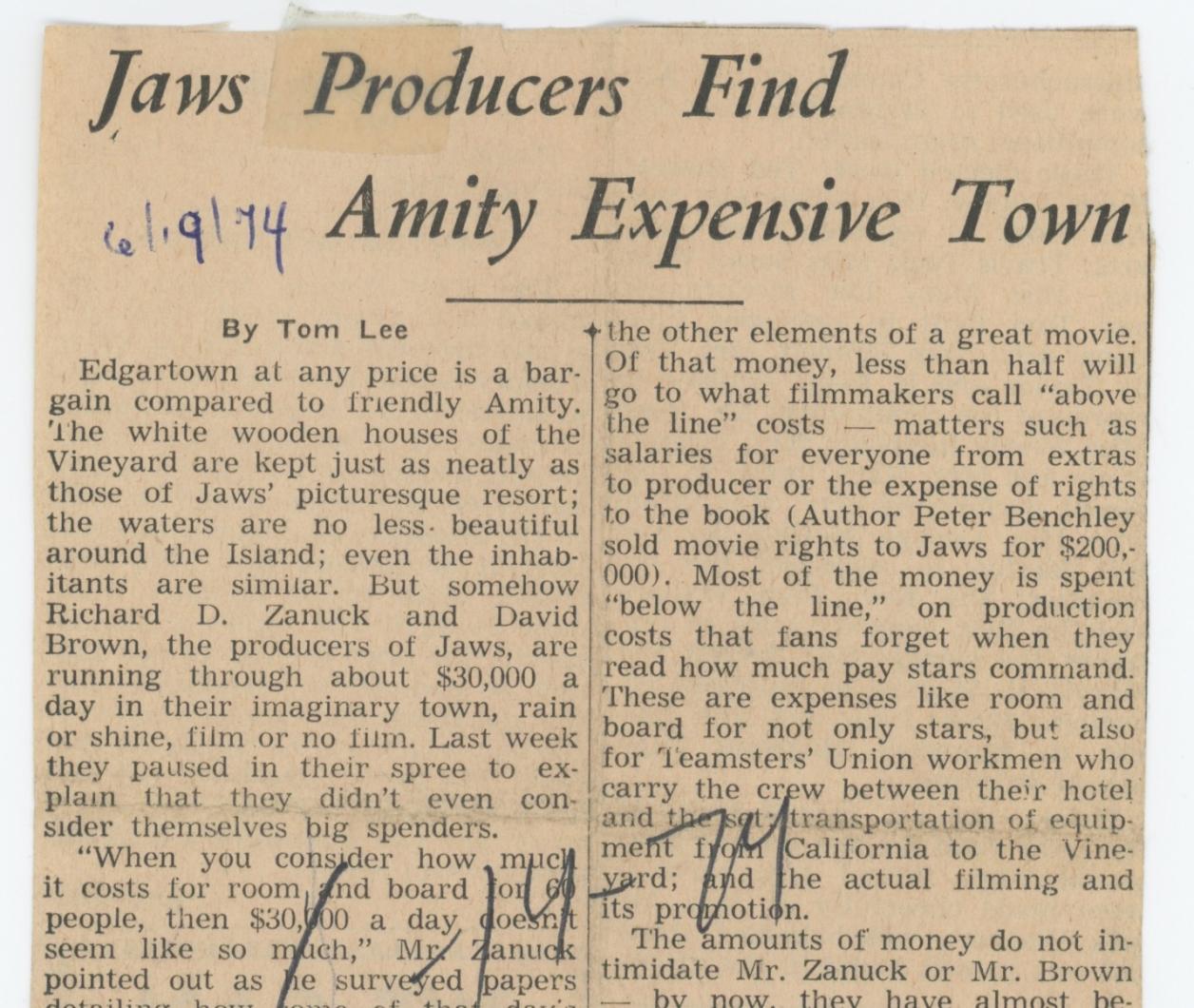



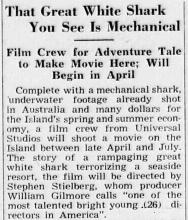
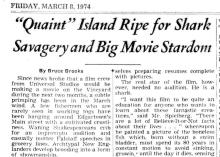
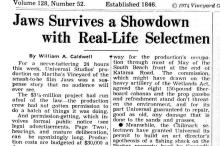
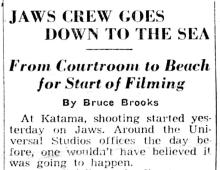

Comments